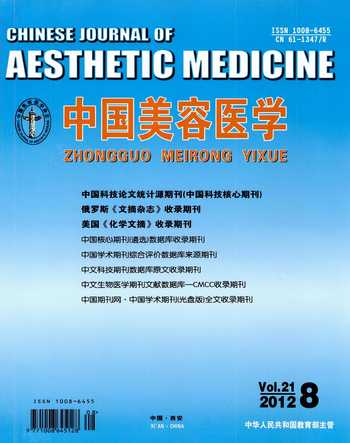白癜风发病机制及治疗策略
高天文 刘玲
近10年来,白癜风发病机制的研究越来越受到重视,全球范围内在皮肤科学界顶级杂志J Invest Dermatol及以上级别杂志刊载相关文章达70余篇,其中新英格兰医学杂志(N Engl J Med)6篇[1-6]、自然遗传杂志(Nature Genet)3篇[7-9],皮肤学界对白癜风的认识正发生着深刻的变化。
2001年,笔者在第四军医大学学报发表了一篇小文章--挑战白癜风治疗[10],限于当年的认识,挑战着眼于三方面:一是中医中药及免疫治疗,二是能大量扩增及建库贮存的异体黑素细胞治疗,三是针对产生黑素细胞自身抗体的B细胞的带毒表位肽治疗。弹指一挥间,10年前的一些认识很快已成为历史。得益于紫外光设备技术的进步及黑素细胞培养技术的进步,白癜风的治疗效果也早已是今非昔比,然而,白癜风的临床治疗研究仍然还有漫长的路。从宏观看,白癜风治疗的突破有赖于发病机制的充分阐明及基于发病机制而制定的治疗策略。
1白癜风发病机制研究概况
白癜风发病机制涉及到遗传、黑素细胞凋亡、神经内分泌、自身免疫、氧化应激、细胞因子等许多方面,各种发病假说多达7、8个,彼此间有联系也有矛盾, Le poole[11]曾提出汇聚学说(convergence theory),即:遗传、应激、有毒化合物的聚集、感染、自身免疫、突变、细胞内环境的改变以及黑素细胞迁移和增殖能力的减弱等多因素、多基因累积共同导致了白癜风的发生,不同的个体则可能存在不同病因的组合。
近年白癜风发病机制研究最重要的进展在于三个方面:细胞免疫、氧化应激、基于分子生物学的遗传研究。①CD8+ CTL所参与的免疫应答在黑素细胞破坏中发挥重要的杀伤效应:大量的研究发现进展期白癜风患者皮损处CD8+和CD4+ T细胞所占比例均升高,但以CD8+T细胞最为显著;体外实验发现从皮损处分离的CD8+T淋巴细胞可以特异性杀伤黑素细胞,引起皮肤色素脱失[12-13];②白癜风患者黑素细胞氧化应激平衡障碍:皮肤作为机体的屏障,承受着内外环境中活性氧簇(reactive oxygen species, ROS)的攻击;白癜风患者皮肤局部过氧化氢酶水平下降[14],表皮H2O2的浓度远高于正常水平,角质形成细胞可将H2O2输送给邻近黑素细胞[15],从而灭活多种抗氧化酶类,包括DMSR、CAT、GST、乙酰胆碱酯酶和MsrA,这些酶类在白癜风患者皮损区活性均有明显降低[16-19],从而进一步加剧了ROS的聚集。我们的研究发现,与自身免疫或氧化应激相关的基因,如FAS/FASL、COX2、GST、CAT、iNOS及COMT等基因变异在白癜风发生、发展中有重要作用[16,20-24];③多个免疫及色素相关的基因与白癜风密切相关:Spritz及张学军两个团队利用全基因组关联分析技术(genome-wide association analysis, GWS)在国际最权威的学术期刊发表多篇文章[2,7-9],这些发现为白癜风发病的遗传学说找到了充分的依据[2,7-9,20-24]。
2白癜风治疗策略
从目前的研究手段及认知水平看,“改良土地”即在基因水平上进行治疗尚无法实现;“播种”即黑素细胞移植,目前已获得了很大进展,特别是许爱娥研究团队在此领域做出了杰出贡献[25,26];“播种”需在充分“除虫”后方能实现,所以“除虫”应为当前及今后的研究重点。近年白癜风治疗最大的进展是NB-UVB及准分子激光的应用,这些技术主要通过抑制或破坏浸润于皮损的T细胞而达到目的。根据我们的白癜风发病机制假说,氧化应激为白癜风发生的始动因素,未来治疗的着眼点应在抗氧化剂的使用上,在目前的NB-UVB及准分子激光治疗进展基础上,如果有一种或几种特异性较高的抗氧化剂能应用于临床,白癜风的治疗将获得真正的突破。
[参考文献]
[1]Ta1eb A,Picardo M.Clinical practice.Vitiligo[J].N Engl J Med,2009,360(2):160-169. Review.
[2]Jin Y,Birlea SA,Fain PR,et al.Variant of TYR and autoimmunity susceptibility loci in generalized vitiligo[J].N Engl J Med,2010,362(18):1686-1697.
[3]Naldi L,Sassi F.Vitiligo[J].N Engl J Med,2009,23,360(17):1788.
[4]Redondo P,Del Olmo J.Images in clinical medicine.Vitiligo and cutaneous melanoma[J].N Engl J Med,2008,359(3):e3.
[5]Jin Y,Mailloux CM,Gowan K,et al.NALP1 in vitiligo-associated multiple autoimmune disease[J].N Engl J Med,2007,356(12):1216-1225.
[6]Egli F,Walter R.Images in clinical medicine.Vitiligo and pernicious anemia[J].N Engl J Med,2004,350(26):2698.
[7]Jin Y,Birlea SA,Fain PR,et al.Genome-wide association analyses identify 13 new susceptibility loci for generalized vitiligo.Nat Genet, 2012,44(6):676-80.
[8]Jin Y,Birlea SA,Fain PR,et al.Common variants in FOXP1 are associated with generalized vitiligo[J].Nat Genet,2010,42(7):576-8.
[9]Quan C,Ren YQ,Xiang LH,et al.Genome-wide association study for vitiligo identifies susceptibility loci at 6q27 and the MHC[J].Nat Genet,2010,42(7):614-618.
[10]高天文.挑战白癜风治疗(述评)[J].第四军医大学学报,2001,22:2213-2215.
[11]Le Poole IC, Das PK, van den Wijngaard RM,et al.Review of the etiopathomechanism of vitiligo: a convergence theory[J]. Exp Dermatol, 1993,2(4):145-153.
[12]van den Boorn JG,Konijnenberg D,Dellemijn TA,et al.Autoimmune destruction of skin melanocytes by perilesional T cells from vitiligo patients[J].J Invest Dermatol,2009, 129:2220-2232.
[13]Garbelli S,Mantovani S,Palermo B,et al.Melanocyte-specific, cytotoxic T cell responses in vitiligo:the effective variant of melanoma immunity[J]? Pigment Cell Res,2005,18:234-242.
[14]Schallreuter KU,Wood JM,Berger J.Low catalase levels in the epidermis of patients with vitiligo[J].J Invest Dermatol,1991,97:1081-1085.
[15]Pelle E, Mammone T, Maes D,et al.Keratinocytes act as a source of reactive oxygen species by transferring hydrogen peroxide to melanocytes[J].J Invest Dermatol,2005,124:793-797.
[16]Zhou Z,Li CY,Li K,et al.Decreased methionine sulphoxide reductase A expression renders melanocytes more sensitive to oxidative stress: a possible cause for melanocyte loss in vitiligo[J].Br J Dermatol,2009 161(5):504-509.
[17]Schallreuter KU,Rubsam K,Gibbons NC,et al.Methionine sulfoxidereductases A and B are deactivated by hydrogen peroxide (H2O2) in the epidermis of patients with vitiligo[J].J Invest Dermatol,2008,128:808-815.
[18]Sravani PV,Babu NK,Gopal KV,et al.Determination of oxidative stress in vitiligo by measuring superoxide dismutase and catalase levels in vitiliginous and non-vitiliginous skin[J].Indian J DermatolVenereolLeprol,2009,75:268-271.
[19]Kostyuk VA,Potapovich AI,Cesareo E,et al.Dysfunction of glutathione s-transferase leads to excess 4-hydroxy-2-nonenal and H2O2 and impaired cytokine pattern in cultured keratinocytes and blood of vitiligo patients[J].Antioxid Redox Signal,2010,13:607-620.
[20]Li K,Li C,Gao L,et al.A functional single-nucleotide polymorphism in the catechol-O-methyltransferase gene alter vitiligo risk in a Chinese population[J].Arch Dermatol Res,2009,301:681-687.
[21]Li M,Gao Y,Li C,et al.Association of COX2 functional polymorphisms and the risk of vitiligo in Chinese populations.J DermatolSci, 2009, 53:176-181
[22]Li M,Sun D,Li C,et al.Functional polymorphisms of the FAS gene associated with risk of vitiligo in Chinese populations: a case-control analysis[J].J Invest Dermatol, 2008,128:2820-2824.
[23]Liu L,Li C,Gao J,et al.Genetic polymorphisms of glutathione S-transferase and risk of vitiligo in the Chinese population. J Invest Dermatol, 2009, 129:2646-2652.
[24]Liu L LC, Gao J.Promoter variant in the catalase gene is associated with vitiligo in Chinese people[J].J Invest Dermatol,2010,130(11):2647-2653.
[25]Lu N,Xu A,Wu X.Follow-up study of vitiligo patients treated with autologous epidermal sheet transplants[J].J Dermatolog Treat,2012,6.[Epub ahead of print]
[26]Hong WS,Hu DN,Qian GP,et al.Ratio of size of recipient and donor areas in treatment of vitiligo by autologous cultured melanocyte transplantation[J].Br J Dermatol,2011,165(3):520-525.
[收稿日期]2012-06-15
编辑/张惠娟

